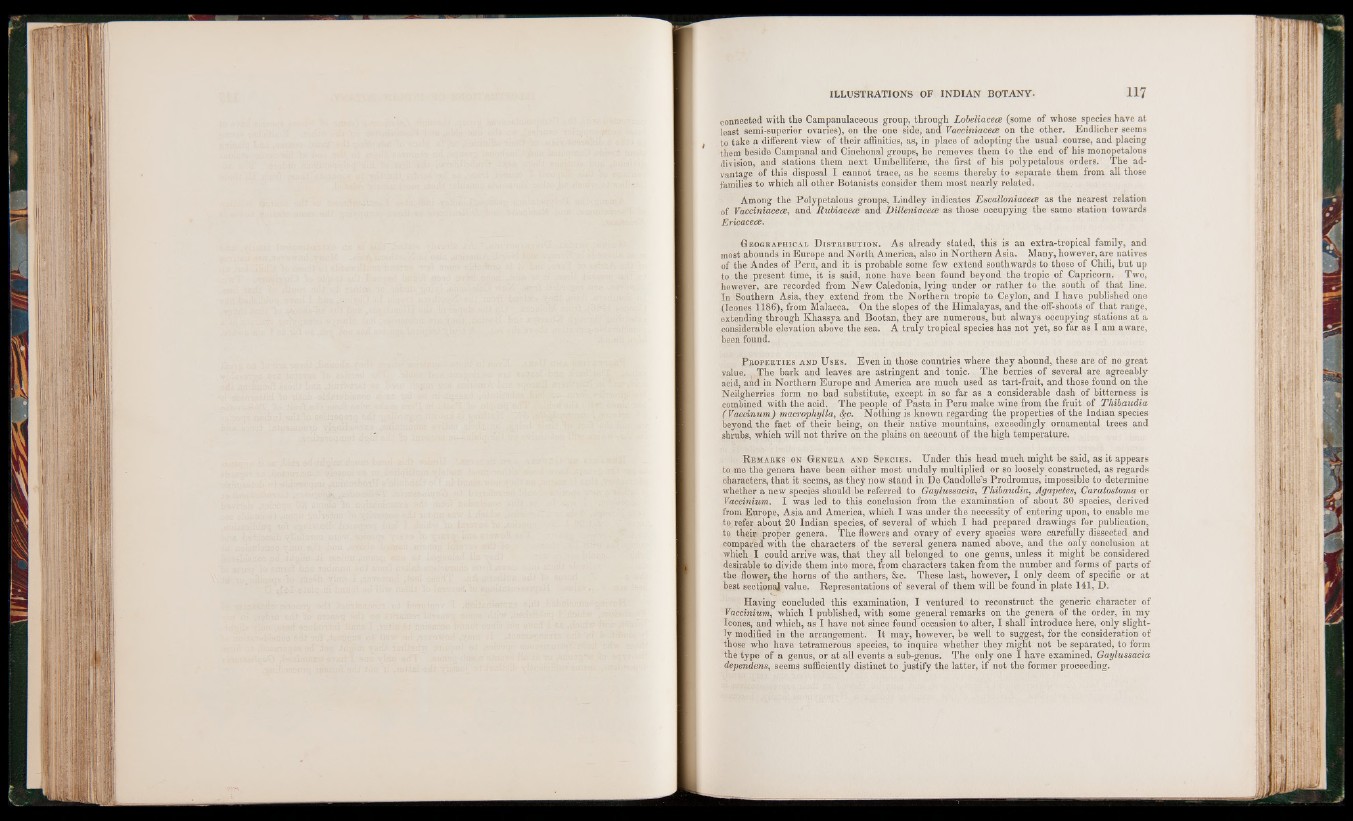
connected with the Campanulaceous group, through Lobeliacece (some of whose species have at
least semi-superior ovaries), on the one side, and Vacciniacece on the other. Endlicher seems
to take a different view of their affinities, as, in place of adopting the usual course, and placing
them beside Campanal and Cinchonal groups, he removes them to the end of his monopetalous
division, and stations them next Umbelliferae, the first of his polypetalous orders. The advantage
of this disposal I cannot trace, as he seems thereby to separate them from all those
families to which all other Botanists consider them most nearly related.
Among the Polypetalous groups, Lindley indicates Escalloniacece as the nearest relation
of Vacciniacece, and Rubiacece and Dilleniacece as those occupying the same station towards
Ericacece.
Geographical Distribution. As already stated, this is an extra-tropical family, and
most abounds in Europe and North America, also in Northern Asia. Many, however, are natives
of the Andes of Peru, and it is probable some few extend southwards to those of Chili, but up
to the present time, it is said, none have been found beyond the tropic of Capricorn. Two,
however, are recorded from New Caledonia, lying under or rather to the south of that line.
In Southern Asia, they extend from the Northern tropic to Ceylon, and I have published one
(leones 1186), from Malacca. On the slopes of the Himalayas, and the off-shoots of that range,
extending through Khassya and Bootan, they are numerous, but always occupying stations at a
considerable elevation above the sea. A truly tropical species has not yet, so far as I am aware,
been found.
P roperties and Uses. Even in those countries where they abound, these are of no great
value. The bark and leaves are astringent and tonic. The berries of several are agreeably
acid, and in Northern Europe and America are much used as tart-fruit, and those found on the
Neilgherries form no bad substitute, except in so far as a considerable dash of bitterness is
combined with the acid. The people of Pasta in Peru make wine from the fruit of Thibaudia
(Vaccinum) macrophyllo, §c. Nothing is known regarding the properties of the Indian species
beyond the fact of their being, on their native mountains, exceedingly ornamental trees and
shrubs, which will not thrive on the plains on account of the high temperature.
Remarks on Genera and Species. Under this head much might be said, as it appears
to me the genera have been either most unduly multiplied or so loosely constructed, as regards
characters, that it seems, as they now stand in De Candolle’s Prodromus, impossible to determine
whether a new species should be referred to Gaylussacia, Thibaudia, Agapetes, Caratostoma or
Vacdnium. I was led to this conclusion from the examination of about 30 species, derived
from Europe, Asia and America, which I was under the necessity of entering upon, to enable me
to refer about 20 Indian species, of several of which I had prepared drawings for publication,
to theic proper genera. The flowers and ovary of every species were carefully dissected and
compared with the characters of the several genera named above, and the only conclusion at
which I could arrive was, that they all belonged to one genus, unless it might be considered
desirable to divide them into more, from characters taken from the number and forms of parts of
the flower, the horns of the anthers, &c. These last, however, I only deem of specific or at
best sectional value. Representations of several of them will be found in plate 141, D.
Having concluded this examination, I ventured to reconstruct the generic character of
Vacdnium, which I published, with some general remarks on the genera of the order, in my
leones, and which, as I have not since found occasion to alter, I shall introduce here, only slightly
modified in the arrangement. I t may, however, be well to suggest, for the consideration of
those who have tetramerous species, to inquire whether they might not be separated, to form
the type of a genus, or at all events a sub-genus. The only one I have examined, Gaylussada
dependens, seems sufficiently distinct to justify the latter, if not the former proceeding.